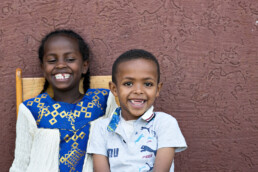Ethiopia
Ethiopia is located in eastern Africa and has the second largest population in Africa. It is also one of the oldest countries in the world. The country was occupied by Mussolini’s Italy for five years during World War II, but has never been a colony.
From 1930 to 1974, Ethiopia was ruled by Emperor Haile Selassie. Haile Selassie was ousted from power, and until 1991, Ethiopia was plagued by several bloody coups, riots, droughts, famines and massive refugee problems. A long border conflict with Eritrea has drained the country of resources.
Despite economic growth in recent years, the country is still among the poorest in the world. Coffee is the largest export commodity, and the Ethiopian economy is completely dependent on agricultural production, but agriculture is hampered by drought and soil erosion.
Children in Ethiopia
Almost half will finish schooling. Although Ethiopia is making an effort to get everyone in school, the school system is maxed with up to 70 students in each class, outdated textbooks and poorly educated teachers.
According to UNESCO, only 39 percent of adult Ethiopians and 55 percent of young Ethiopians can read and write. This is partly due to the fact that their parents could not afford to send them to school.
Instead of going to school, many boys work in agriculture or as day laborers, while girls are employed as domestic workers in cities or abroad to earn money for their families.
This means that Ethiopia must make a special effort to live up to World Goal 8, which must promote decent jobs for all and which states that all countries must stop the worst forms of child labor.
In Ethiopia, 3.5 million children have lost one or both parents, according to UNICEF. Among the orphans, girls in particular have difficulty because they often have to act as parents for their siblings.
SOS Children’s Villages has seven village communities in Ethiopia and also helps parents look after their children in kindergarten, gain access to medical clinics, go to school and receive further education.
One of the children who has been given a new home in an village community is Abeba. Abeba was only a year old when her mother left her. Her father’s family reluctantly accepted her, but they did not take proper care of her. They only gave her the food they had left over and she got no care.
When Abeba came to the village community in Jimma in western Ethiopia, she was very malnourished, weak and filthy. Today, she lives a completely ordinary childhood with schooling, friends and lots of time and space to play and just be a child. She is a real joker, and when she grows up, she wants to be a teacher.

Facts about children
- 41 percent of Ethiopia’s population is under the age of 14.
- There are 3.5 million orphans.
- 450,000 children have lost one or both parents to AIDS.
- 59 children out of 1,000 die before they turn 5 years old.
- About 43 percent of all children complete schooling. 15 percent complete the intermediate stage and schooling. 13 percent get a high school diploma.
- More than one in four children is malnourished, and 40 percent of all children do not develop as they should due to malnutrition or malnutrition.
Country facts
- Over 99 million people live in Ethiopia.
- An Ethiopian earns an average of 560 euro a year or just over 1,5 euro a day.
- 1.2 percent of all Ethiopians between the ages of 15 and 49 live with HIV or AIDS.
- For every 100,000 children born, 353 Ethiopian women die from complications during pregnancy or childbirth.
- The birth rate in Ethiopia is 32 per 1,000 Ethiopians.
- An Ethiopian woman can expect to live for 66 years and a man 62 years.
- 33.5 percent of the population lives below the $ 1.90 poverty line per day.
Village communities in Ethiopia
Support MY FOUNDATION's work in Ethiopia, or become a partner in a project or a village community in the country.